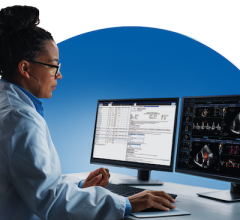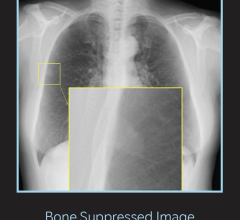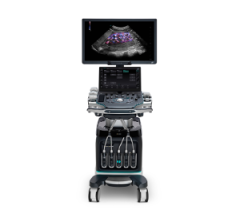
The first of three clinical scenarios presented to the panel with final recommendations. Mild features refer to absence of significant pulmonary dysfunction or damage. Pre-test probability is based upon background prevalence of disease and may be further modified by individual’s exposure risk. The absence of resource constraints corresponds to sufficient availability of personnel, personal protective equipment, COVID-19 testing, hospital beds, and/or ventilators with the need to rapidly triage patients. Contextual detail and considerations for imaging with CXR (chest radiography) versus CT (computed tomography) are presented in the text. (Pos=positive, Neg=negative, Mod=moderate). [Although not covered by this scenario and not shown in the figure, in the presence of significant resources constraints, there is no role for imaging of patients with mild features of COVID-19.] Image courtesy of the journal Radiology
April 7, 2020 — A multinational consensus statement from the Fleischner Society on the role of chest imaging in the management of patients with COVID-19 was jointly published today in the journals Radiology and Chest.
“We need to understand that conditions across the globe vary greatly. Our goal in developing this statement was to offer guidance that is sensitive to these differences and applicable broadly,” said Geoffrey D. Rubin, M.D., George B. Geller Professor of Cardiovascular Research, professor of radiology and bioengineering at Duke University School of Medicine in Durham, N.C.
The statement represents the collective opinions and perspectives of thoracic radiology, pulmonology, intensive care, emergency medicine, laboratory medicine and infection control experts practicing in 10 countries, representative of the highest burden of COVID-19 worldwide.
“The willingness of experts from around the world to pause from their care of patients to contribute their knowledge and experience toward this international consensus was inspiring,” Rubin said.
Chest computed tomography (CT) and X-ray are key tools in the diagnosis and management of numerous respiratory ailments, but their role in the management of COVID-19 has not been considered within the context of many variables, including the severity of respiratory disease, pre-test probability, risk factors for disease progression, and critical resource constraints.
“The Fleischner statement was uniquely comprised of a multidisciplinary panel comprised principally of radiologists and pulmonologists from 10 countries with experience managing COVID-19 patients across a spectrum of healthcare environments,” said Radiology Editor David A. Bluemke, M.D.
The panel evaluated the utility of imaging within three scenarios representing varying risk factors, community conditions and resource constraints.
Fourteen key questions, corresponding to 11 decision points within the three scenarios and three additional clinical situations, were rated by the panel based upon the anticipated value of the information that thoracic imaging would be expected to provide. The results were aggregated, resulting in five main and three additional recommendations intended to guide medical practitioners in the use of chest X-ray and CT in the management of COVID-19.
The results suggested that imaging is not routinely indicated in asymptomatic individuals or patients with suspected COVID-19 and mild clinical symptoms. Use of chest imaging is indicated in patients with COVID-19 who have worsening respiratory status. Imaging is also indicated for patients with moderate to severe features of COVID-19 regardless of COVID-19 test results.
In a resource-constrained environment (lack of personal protection equipment or availability of COVID-19 testing), imaging is indicated for medical triage of patients with suspected COVID-19 who present with moderate to severe clinical features and a high pre-test probability of disease.
The panel also found that CT is appropriate in patients with functional impairment and/or hypoxemia (low level of oxygen in the blood) after recovery from COVID-19. When there is known community transmission, evidence of COVID-19 has been incidentally found on CT scans. In these cases, patients should have COVID-19 testing using a reverse-transcription polymerase chain reaction (RT-PCR) viral assay.
The authors note that this consensus statement represents opinion at a moment in time within a highly dynamic environment where the status of regional epidemics and the availability of critical resources to combat those epidemics vary daily. Recommendations may undergo refinement as the situation evolves.
“Currently, no therapy has been confirmed to alter the course of COVID-19, there is no known cure, and there is no vaccine for prevention,” Rubin said. “As effective treatments are developed, thoracic imaging may find new roles by establishing treatment response or characterizing patients as likely responders to novel therapies.”
For additional resources: RSNA’s COVID-19 Resources
An associated special edition podcast from Dr. Bluemke is available.


 December 17, 2025
December 17, 2025 









